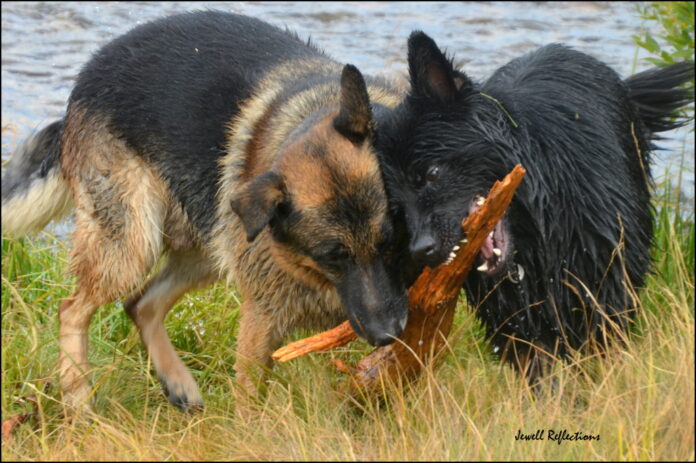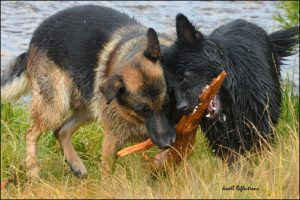
BY FRAN JEWELL

There are many interpretations out there about why dogs hump each other. We are totally confused when we see males hump other males, or females hump males, or females hump females. We are even more confused when our dog humps his or her bed—or US!
The fact is, like with all dog behavior, there are many reasons why dogs hump. So it’s important to see it in context with the rest of the relationship a dog has with another dog. Previously, I always thought it was a dominance gesture. But then I witnessed a female in season humping her intended male. This clearly was not dominance. Her intent was to gain interest from the male.
Some dogs will use humping as a way to initiate play with a dog they have a good friendship with, as a friendship gesture. They tend to hump and run! Humping a pillow or other non-living thing can be either because it simply feels good, or from frustration.
When Kalidor was 17 months old, he was establishing himself as a mature male in my pack. I had two older males, Brinx and Baewulf. Brinx was the clear highest-ranking dog (notice I didn’t call him an “alpha”) in my household. Baewulf was the peacemaker.
Kalidor had many times tried to push Brinx around and test the waters to see if maybe he could take over from Brinx. Brinx had been clear that, no, that won’t happen. Brinx was very tolerant, but also very firm. Then Kalidor moved his focus onto Baewulf. Almost every day I saw Kalidor humping Baewulf. Baewulf could not have cared less. The action was of no significance to him.
I saw this particular humping gesture as Kalidor trying to pass Baewulf in social status in our pack. Why? Because all of Kalidor’s other behaviors and age would suggest that the timing was right, but also his previous challenges to Brinx indicated he is testing the waters. If Brinx was not in the group, I would have thought that the humping would suggest an expression of friendship with Baewulf.
The question always becomes: What do you do if a dog humps you or another dog?
When a dog humps another dog, I think the reaction of the “humpee” is important. If the humpee is bothered and the humper won’t stop, then I tend to intervene and stop the interaction. If the humpee has no issues, then I do not intervene.
If the dog humps me, I never allow it. I don’t feel it is appropriate and many times indicates lack of respect or a challenge to my leadership, much like jumping on me.
In general, as with all dog behavior, there are many meanings to each behavior. The important thing is to look at all the behaviors and attitudes to help determine the meaning at that moment. It is then that the meaning should become clearer to you.
Fran Jewell is an Idaho Press Club award-winning columnist, IAABC-certified dog behavior consultant, NADOI-certified instructor #1096 and the owner of Positive Puppy Dog Training, LLC, in Sun Valley. For more information, visit positivepuppy.com or call (208) 578-1565.


